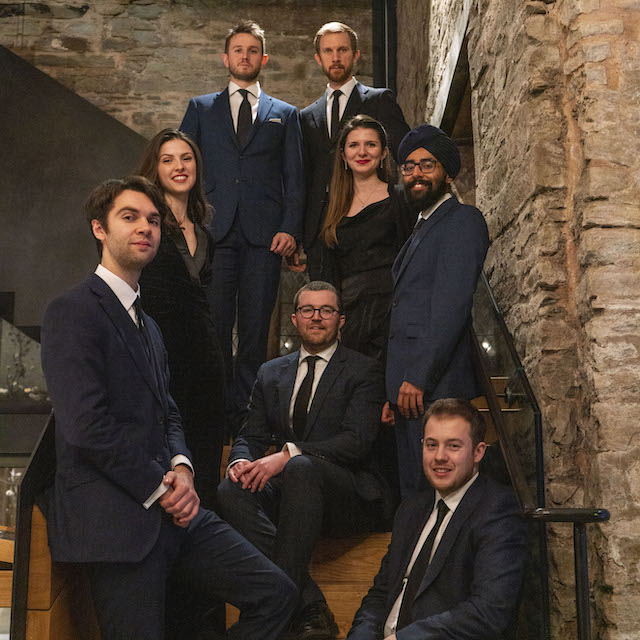This powerful, haunting tribute to William Byrd – performed by the HEXAD Collective – was made particularly distinctive by its performance in the resonant, atmospheric setting of the Brunel Tunnel Shaft in Rotherhithe. When Brunel and his father designed this chamber – which sinks 50 feet below ground – it was to create an entrance to the first tunnel beneath the Thames; today, in its post-industrial incarnation, it has one of the most sonorous acoustics in the country.
True, that comes with its drawbacks – every Overground train that passes makes its presence felt and more surprisingly you can hear the muted whine of planes passing overhead. Yet in a concert that celebrated a composer forced to live a double life because of his Catholic sympathies, the sinister subterranean rumbles felt like an apt reminder of the hostility that swirled around his work.
The first piece, Nunc scio vere, written by Byrd as an introit for a mass for the summer festival of St Peter and St Paul, quickly swooped us into an exquisite sound world that eclipsed the trains. In counterpoint to the political turbulence which meant that – at certain points – you could be arrested simply for possessing a copy of Byrd’s music, here the sophisticated, mellifluous interweaving of voices created a sense of transcendent calm.
 In the Elizabethan age, of course, such skilfully wrought polyphony was in itself a rebellion against the more austere musical aesthetic of the Anglican church. This opening number beautifully demonstrated both the subversiveness and the skill inherent to Byrd’s ability to weld together passages of extraordinary mathematical complexity so that they shimmered like burnished gold.
In the Elizabethan age, of course, such skilfully wrought polyphony was in itself a rebellion against the more austere musical aesthetic of the Anglican church. This opening number beautifully demonstrated both the subversiveness and the skill inherent to Byrd’s ability to weld together passages of extraordinary mathematical complexity so that they shimmered like burnished gold.
The director of the eight-strong HEXAD Collective (pictured above and main picture), countertenor Daniel Gethin, explained that the concert’s title was a pun on the fact that it was simultaneously a commemoration of Byrd and an introduction of works composed in his style. The chamber choir has two gifted composers among its members, and the first new composition of the evening, a Kyrie, was created by bass singer Piers Kennedy.
Kennedy, whose work has been performed by ensembles including the Gesualdo Six and St John’s College Choir, Cambridge, has created a ravishing piece that both echoes Byrd’s contrapuntal rigour and heightens it with a swooning dissonance. To the contemporary ear, this dissonance gives a more vivid impression of the religious pressure-cooker in which Byrd operated, weaving an almost hallucinatory terror into the beauty.
The sensitive acoustic meant that through the course of the concert every voice in this group had a chance to shine, not least Kennedy’s reverberant bass. In the Constitues eos it was Danni O’Neill’s soprano who came to the fore, bringing a light and richness to the ascending passages that was offset by the darker textured interplay of the other voices.
Byrd’s Catholic masses at Ingatestone – the Essex family home of Sir William Petre, where most of these services were held – often featured women singers in contrast to his works for Chapel Royal which were sung by boy choristers. It felt apt then that the programme also featured two women composers from the 16th century – Maddalena Casulana and Rafaella Aleotti – as well as two contemporary female composers, the 94-year-old Margaret Rizza and the HEXAD Collective’s Anna Semple.
Casulana’s O Notte, O Ciel completed the first part of the concert, demonstrating the Italian’s skill for creating music that was both intellectually agile and accessible in its opulent harmonies. Then we were onto the second part of the concert, framed by what Gethin described as the “fizz and crackle” of Byrd’s music for the feast of the Assumption of the Virgin Mary. In the Gaudeamus omnes, soprano Fiona Fraser and mezzo soprano Anna Semple took the helm, their voices soaring higher and higher in a dramatic evocation of the spiritual ecstasy of this most Catholic of festivals. This was followed by the thrilling Assumpta est Maria which made the whole chamber ring.
Semple’s first composition of the concert – a new Sanctus and Benedictus based on Byrd’s Mass for Four Voices – placed the singers around the chamber, building on Byrd’s original music phrases to create a work of ethereal allure. Following the detailed dynamism of Aleotti’s Vidi Speciosam, Semple’s Agnus Dei played more overtly with musical texture, weaving the harmonies over a bass that alternated between sustained notes and an agitated staccato.
After a transcendent delivery of Byrd’s Optimam Partem Elegebit we arrived at the final piece of the evening, Margaret Rizza’s Ave Generosa. The opening soprano statements quickly built into a rich soundscape, with the tenors Gopal Kambo and Sebastian Hill and baritone Simon Grant deftly melding their voices to bring out the composition’s full sonority. In the final passages the vividness of the sopranos made the music gleam like sunlight bouncing off metal. It was a wonderful ending to an evening that was as spectacular as it was thoughtful.



Add comment